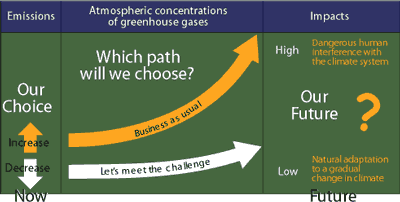| ||||||||||||||||||||||||||||
Proactive disclosure Print version |  Weathering the changes: Climate change in Ontario Where do we go from here? Think globally Climate change is a global issue requiring international action and co-operation. In 1997, as part of an international initiative to address climate change, 160 nations negotiated an international climate change agreement, the Kyoto Protocol. This agreement identified targets for reduction of GHG emissions. It also requires that countries pursue refinements to the understanding of climate change and development of strategies to adapt. Act locally Reducing GHG emissions will be a significant challenge for Canada. The fact is that even with a 20 to 25% reduction in emissions, the climate will still change, but at a somewhat slower pace. For this reason we need to start developing strategies to adapt to the new climate conditions now. The longer we wait to take action, the fewer options may be available to us. Opportunity knocking? Responding to climate change is presenting us with many opportunities for economic growth, jobs, increased trade and technological advancement, reduced levels of pollution, and a cleaner, healthier environment for many Canadians.  Did you know? It's up to us
References Turner, R.J.W. and Clague, J.J., 1999: Temperature rising: climate change in southwestern British Columbia; Geological Survey of Canada, Miscellaneous Report 67.
|